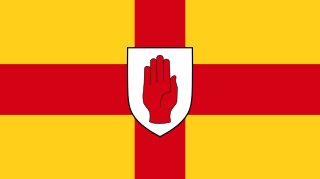
Ulster is one of the four traditional or historic Irish provinces. It is made up of nine counties: six of these constitute Northern Ireland ; the remaining three are in the Republic of Ireland.

The Consolidated Model 28, more commonly known as the PBY Catalina, is a flying boat and amphibious aircraft designed by Consolidated Aircraft in the 1930s and 1940s. In US Army service it was designated the OA-10, in Canadian service as the Canso and it later received the NATO reporting name Mop. It was one of the most widely used seaplanes of World War II. Catalinas served with every branch of the United States Armed Forces and in the air forces and navies of many other nations. The last military PBYs served until the 1980s. As of 2021, 86 years after its first flight, the aircraft continues to fly as a waterbomber in aerial firefighting operations in some parts of the world.

Irvinestown is a town in County Fermanagh, Northern Ireland. At the 2021 census it had a population of 2,325 people. The most notable buildings are Necarne Castle, formerly known as Castle Irvine, and Castle Archdale. Irvinestown is situated within Fermanagh and Omagh district.

Lough Erne is the name of two connected lakes in County Fermanagh, Northern Ireland. It is the second-biggest lake system in Northern Ireland and Ulster, and the fourth biggest in Ireland. The lakes are widened sections of the River Erne, which flows north and then curves west into the Atlantic. The smaller southern lake is called the Upper Lough as it is higher up the river. The bigger northern lake is called the Lower Lough or Broad Lough. The town of Enniskillen lies on the short stretch of river between the lakes. The lake has more than 150 islands, along with many coves and inlets. The River Erne is 80 miles (129 km) long and drains an area of about 1,680 square miles (4,350 km2).
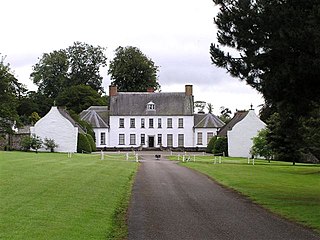
Springhill is a 17th-century plantation house in the townland of Ballindrum near Moneymore, County Londonderry in Northern Ireland. It has been the property of the National Trust since 1957 and, in addition to the house, gardens and park, there is a costume collection and a purported ghost. It is open from March to June, and September on weekends, and is open to the public seven days a week during July and August.
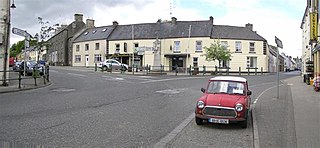
Pettigo, also spelt Pettigoe, is a small village and townland on the border of County Donegal, Republic of Ireland, and County Fermanagh, Northern Ireland. It is bisected by the Termon River which is part of the border between the Republic of Ireland and Northern Ireland.

Cave Hill or Cavehill is a rocky hill overlooking the city of Belfast, Northern Ireland,with a height of 368 metres (1,207 ft). It is marked by basalt cliffs and caves, and its distinguishing feature is 'Napoleon's Nose', a tall cliff resembling the profile of the emperor Napoleon. On top of this are the remains of an ancient promontory fort called McArt's Fort. Cavehill was also historically called 'Ben Madigan', after a king of Ulster called Madagán.
The Crom Estate is a nature reserve located in the south of County Fermanagh, Northern Ireland, along the shores of Upper Lough Erne. It is one of three estates owned and managed by the National Trust in County Fermanagh, the others being Florence Court and Castle Coole mansions. The estate comprises 1,350 acres (5.5 km2), composed primarily of riparian forest. Some trees are so ancient that physical access is restricted.

Kesh is a village in County Fermanagh, Northern Ireland. It is on the Kesh River about 1 mile (1.6 km) from Lower Lough Erne. The 2011 Census recorded a population of 1,039 people. It is within Fermanagh and Omagh district.

Lisnarick or Lisnarrick is a small village in County Fermanagh, Northern Ireland, 4 km west of Irvinestown. It is situated in the civil parish of Derryvullan and historic barony of Lurg. The village was once known as Archdalestown after the nearby Castle Archdale. In the 2011 Census it had a population of 238.
Newtownbutler or Newtown Butler is a small town in County Fermanagh, Northern Ireland. It is in the southeast corner of the county, near Lough Erne, the border with County Monaghan, Republic of Ireland, and the town of Clones. It is surrounded by small lakes and bogland. In the 2011 census it had a population of 989 people.

Donegal Castle is a castle situated in the centre of Donegal Town in County Donegal in Ulster, the northern province in Ireland. The castle was the stronghold of the O'Donnell clan, Lords of Tír Conaill and one of the most powerful Gaelic families in Ireland from the 5th to the 16th centuries. For most of the last two centuries, the majority of the buildings lay in ruins but the castle was almost fully restored in the early 1990s. It is now open to the public.
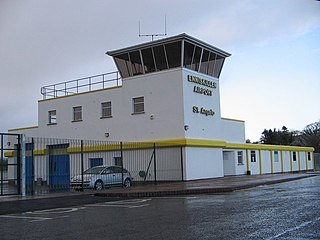
Enniskillen/St Angelo Aerodrome is located 3 nautical miles north of Enniskillen, County Fermanagh, Northern Ireland. The aerodrome has a CAA Ordinary Licence that allows flights for the public transport of passengers or for flying instruction as authorised by the licensee. First built and used during World War II as RAF St Angelo and later renamed St Angelo Barracks while in use as a British Army base, the airfield has been in private ownership as a civilian facility since 1996. The original two runways were reduced to one following the development of the main Enniskillen to Kesh road.
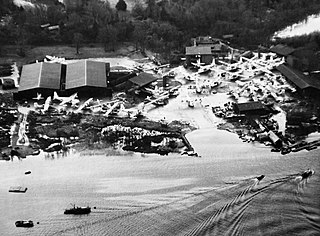
Royal Air Force Castle Archdale or more simply RAF Castle Archdale, also known for a while as RAF Lough Erne is a former Royal Air Force station used for flying boats by the RAF and the Royal Canadian Air Force in County Fermanagh, Northern Ireland.

Royal Air Force St Angelo or more simply RAF St Angelo is a former Royal Air Force station during the Second World War, located near the village of Trory on the southern tip of Lower Lough Erne, 2.5 miles (4.0 km) north of Enniskillen, County Fermanagh, Northern Ireland; also used by the Royal Navy’s Fleet Air Arm. The name St Angelo is believed to be taken from the nearby Bishop's house, which was commandeered during the war as the Station Commander's residence; the name also became attached to the airfield.
The Donegal Corridor was a narrow strip of Irish airspace linking Lough Erne to the international waters of the Atlantic Ocean through which the Irish Government permitted flights by British military aircraft during World War II. This was a contravention of Irish neutrality and was not publicised at the time.

Number 209 Squadron of the British Royal Air Force was originally formed from a nucleus of "Naval Eight" on 1 February 1917 at Saint-Pol-sur-Mer, France, as No. 9 Squadron Royal Naval Air Service (RNAS) and saw active service in both World Wars, the Korean War and in Malaya. The use of the squadron number ceased in 1968 and it has not been reused since by an RAF squadron. However the number, badge and motto is in current service within the RAF Air Cadets at 209 Squadron ATC in Nottinghamshire.
Crom Castle is a country house on the shores of Upper Lough Erne in County Fermanagh, Northern Ireland, the seat of the Earls Erne. Standing within the 1,900-acre (7.7 km2) Crom Estate, and within a formal garden, the castle is built in stone. A central battlemented tower includes the main entrance, and there are also smaller towers to one side. It stands apart from the ruins of Old Crom Castle, of which two towers, some walls, and a ha-ha survive, and near them two ancient yew trees, believed to be at least 800 years old.
Leonard B. "Tuck" Smith was an American pilot who spotted the German battleship Bismarck prior to its being sunk by British naval and air forces. Smith was the first American to participate in a World War II naval victory and is sometimes considered the first American to be directly involved in World War II for his actions.

No. 15 Group was a group of the Royal Air Force, which disbanded in 1945. It was operational in the last year of, and just after, the First World War, a reformation saw it active throughout the Second World War.















